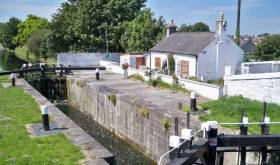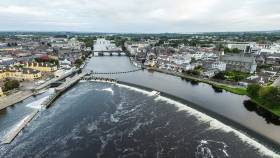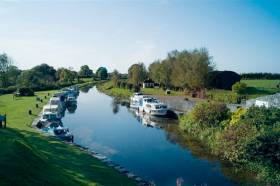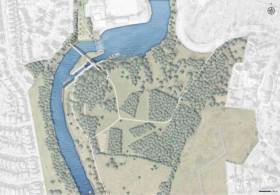Displaying items by tag: inland waters
#InlandWaters - Tourism and activity providers along with local communities along the route are invited to attend a series of workshops aimed at developing the Royal Canal as an attraction for domestic tourism and visitors from abroad.
Coming ahead of next year’s launch of the Royal Canal Greenway, the capacity-building workshops will help project partners engage with local trades, businesses and others to showcase the proposed plans in developing the Royal Canal as a destination.
The long-awaited Blueway and Greenway trails on and along the 144km of canal and towpath from Dublin to Longford will be the focus of the workshops, the first of which will be held next week in Mullingar on Thursday 24 May from 6.30pm at the Mullingar Park Hotel.
Dates and venues for subsequent workshops in Longford town, Maynooth and Dublin are to be confirmed. All are hosted by Waterways Ireland with the respective local authorities.
Once complete, the Royal Canal Greenway will be the longest off-road walking and cycling trail on the island of Ireland.
Accompanying this will be a series of Blueway developments, the first being located in Mullingar where a 22km paddling trail and activity hub will be established.
The workshops will encourage the development of activity based packages, dining and accommodation packages and promotional materials which will activate the region and place the product in the ‘shop window’ for both the domestic and international tourist.
The Royal Canal is also at the heart of Ireland’s Ancient East and Ireland’s Hidden Heartlands, two tourism initiatives developed by Fáilte Ireland.
#InlandWaters - Masters and owners of vessels on the Killaloe Canal are advised that the section between Killaloe road bridge and the control gate structure upstream will be closed for six weeks from later this month.
The 450m long section the waterway will be closed to navigation between Monday 14 May and Saturday 30 June to allow lowering of the water level in the canal for essential maintenance works.
Waterways Ireland advises that all vessels should be removed on or before Monday 14 May.
In other inland waterways news, work continues on installing floating pontoons and a gangway at Regal Pass on the Erne system, with a view to completion this coming Friday 4 May.
The 20 metres of jetty next to the activity hub is reserves to allow access of the floating pontoons and barges, so mooring is not permitted at this location for the time being.
Meanwhile, on the Lower Bann, essential maintenance works at Porta Locks were completed last week and the navigation is now open and operational.
#Tourism - ‘Ireland’s Hidden Heartlands’ is the new tourism brand for the Midlands region, with a particular emphasis on its inland waterways.
More than 10,000 consumers gave their put to Fáilte Ireland on the development of the brand, which hopes to “bring to life the Midlands' rich natural assets including its many lakes, walkways and blueways”.
The River Shannon will be a central focus, with a Shannon Master Plan currently being developed by Fáilte Ireland in partnership with Waterways Ireland to drive tourism opportunities both on and off the water and in surrounding towns.
A series of food networks and trails will also be developed as part of the new brand.
Launching Ireland’s Hidden Heartlands in Athlone last Friday 13 April, Transport Minister Shane Ross said the brand “will significantly enhance the Midlands as a tourism experience and bring growth and jobs to the whole region.
“We have always been committed to ensuring that Ireland’s success as a world-class tourist destination is shared among the regions. Some of the country’s finest natural assets are in the Midlands, including spectacular lakes, walkways and blueways. Ireland’s Hidden Heartlands will bring these gems to life, offering a unique experience to both domestic and international visitors.”
Ireland’s Hidden Heartlands will cover the ‘heart’ of the country, from Leitrim down to East Clare and extending through Longford, Roscommon, East Galway, as well as parts of Westmeath, Cavan, North Tipperary and Offaly.
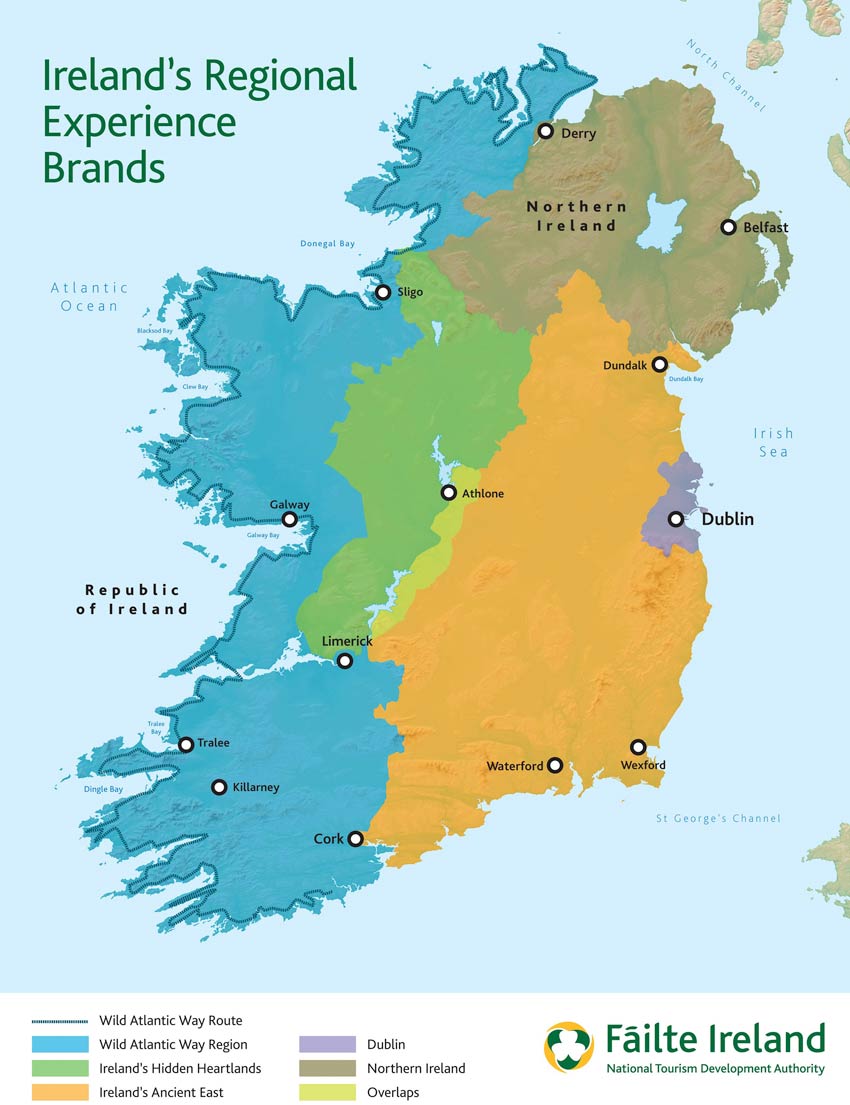
It will complement Fáilte Ireland’s other key brands in the Wild Atlantic Way, Ireland’s Ancient East and Dublin.
“Ireland’s Hidden Heartlands has been developed after months of extensive market testing both here and overseas,” said Paul Kelly, CEO of Fáilte Ireland. “The overwhelming feedback is that visitors from key markets want the opportunity to explore Ireland’s natural gems and rural communities.
“There is also a huge appetite out there for tourists to be active in nature through activities like walking, cycling, angling and boating routes – all of which the Midlands can offer in abundance.”
An initial €2 million has been allocated to start the development stage of the brand, with further funding to follow. This first round of investment will help to develop visitor experiences, support industry development and develop marketing campaigns for the region.
Waterways Ireland Recruiting Inspector Of Navigation
#Jobs - Waterways Ireland is currently recruiting for an Inspector of Navigation based in Athlone, and an engineer based in Dublin.
The Inspector of Navigation will be responsible for a number of strategic work areas, including the monitoring and management of navigational and recreational activities on all of the navigations; enforcement of bye-laws; inspection of aids to navigation and acting as marine safety adviser for the organisation.
The inspector will be responsible for the management of inspectorate staff and will work closely with senior managers and colleagues in operations to deliver business objectives.
They will also represent Waterways Ireland at national and international level, pro-actively promoting the interests of all stakeholders, and the navigational and recreational remit of Waterways Ireland.
Inspectorate staff are based in each of Waterways Ireland Operational Regions, Western, Northern and Eastern, and work as part of the management and operational teams in these regions.
The Inspector of Navigation is based in Athlone and is part of the Western Region Operations team. In addition, the Inspector of Navigation provides a central management support to all inspectorate staff across their regions.
Further details of the role and how to apply can be found on the Waterways Ireland website. The closing date for applications is Monday 29 January.
The Engineer (Operations) will form part of an operational management team and will oversee management/maintenance, recreational/commercial use and future development of Waterways Ireland infrastructure within the Dublin metropolitan area, as required.
The successful applicant will be required to manage operational staff and consultants/contractors working on Waterways Ireland property for implementation of new or refurbishment projects, co-ordinate with user groups for facilitation of events, and work in partnership with third parties and local interests to manage and develop the canals for increased recreational use.
More details of the role and how to apply are available on the Waterways Ireland website. The closing date for applications to this position is Monday 5 February.
New Lease Of Life For Royal Canal Lock House
#RoyalCanal - In news you may have missed from this year, the first lock house on the Royal Canal in Dublin is set for a new lease of life.
A familiar sight for locals and commuters in the city’s North Strand district, the cottage by Newcomen Bridge has been out of use for a number of years since its last residents, the Lynch family, moved on after four decades.
Now Waterways Ireland says it’s to be taken over by The Adventure Project, a city-based non-profit that runs adventure therapy programmes for addiction services, crime diversion projects and young people in care.
It’s expected that the cottage will become a base for a new canal adventure programme, making use of an already lively inland waterway amenity.
Athlone To Host World Canals Conference Next September
#InlandWaters - Waterways Ireland and the Inland Waterways Association of Ireland will host the World Canals Conference 2018 in Athlone next September on the shores of Ireland’s longest waterway, the River Shannon.
‘Restoring, regenerating, re-imagining’ is the theme of the three-day conference from 10-12 September at the Radisson Blu Hotel Athlone that will feature various tours and sessions designed to inspire and connect delegates from all over the globe.
Register soon for to take advantage of the early bird rates ranging from €345 to €385. Some conference tours also have limited numbers so book early to secure your preferred tour and discount.
Special prices are also available for accommodation on board a luxury hire cruiser before, during and after the conference.
Cruisers can be booked for four to 14 nights, with four nights’ free mooring at the full service marina adjacent to the conference venue for the first 10 bookings.
For prospective conference speakers, the organisers are inviting abstract submissions till 28 February 2018 within the remit of the theme across the engineering, tourism, recreation, health and well-being, communications, technology, and arts and heritage sectors.
For more on the event, visit the World Canals Conference 2018 website or sign up for the newsletter for regular updates.
Waterways Ireland Archive Exhibition in Mullingar Celebrates 200 Years of the Royal Canal
#RoyalCanal - A forthcoming exhibition in Mullingar Library will celebrate 200 years of the Royal Canal through images and drawings from the Waterways Ireland archive.
Featuring a selection of images from the archive and from the Ruth Delany and Ian Bath Collections, the exhibition reveals the fascinating history of the Royal Canal over the past 200 years.
The photographs on display are a snapshot of the long history of the inland waterway but they are also testament to the work and efforts of individuals like Ruth Delany and Ian Bath to personally document its deterioration from the 1970s onwards and to highlight an awareness of the canal during the years of lobbying for support for its restoration.
The exhibition will be on display in Mullingar Library from next Monday 27 November to Friday 8 December during library opening hours:
Monday 10am to 5:30pm
Tuesday 10am to 8pm
Wednesday 11am to 5.30pm
Thursday 10am to 8pm
Friday 10am to 5pm
Saturday 10am to 1.30pm
No Further Passage In 2017 On Grand & Royal Canals
#InlandWaters - Waterways Ireland wishes confirms that no further boat movements will be organised into or out from Dublin east of Lock 12 on the Grand and Royal Canals until the 2018 season.
The Grand Canal will shortly be closed for works in the Bluebell area in Dublin, and water levels will be reduced for the winter season.
Waterways Ireland apologies for any inconvenience this may cause its customers and thanks their customers for their understanding in this matter.
Heritage In The Community Grant Scheme 2018 Now Open For Waterways Projects
#InlandWaters - In support of the Waterways Ireland Heritage Plan 2016-2020, the Heritage in the Community Grants Scheme for 2018 is now open for applications.
A fund of €20,000 has been allocated to assist community-based heritage projects which compliment or fulfil the delivery of the Waterways Ireland Heritage Plan along the Barrow Navigation, Erne System, Grand Canal, Lower Bann, Royal Canal, Shannon, Shannon-Erne and the Ulster Canal (Upper Lough Erne to Clones).
Applications will be considered from communities seeking assistance for projects related to inland waterways heritage, including data collection and research; good heritage practice in managing sites, collections, objects and more; and supporting fresh approaches and initiatives that link heritage to communities, promoting active engagement.
The deadline for receipt of completed applications, by email or post, is Wednesday 31 January 2018. Further details on the Heritage Grant Scheme are available on the Waterways Ireland website.
Work Begins In Belfast On Lagan Canal Revival
#InlandWaters - Work has begun on the restoration of the Lagan Canal from Belfast to Lough Neagh, according to the Belfast Telegraph.
The £4 million scheme to reopen the 27-mile inland waterway, which dates from the 18th century, provides for the first new boat lock in Belfast for more than 250 years, as previously reported on Afloat.ie.
It’s understood that works on the weir in Stranmills will be completed by next spring, allowing for proper regulation of water flows ahead of the canal’s future reopening to traffic alongside the already popular towpath.
The Belfast Telegraph has more on the story HERE.































